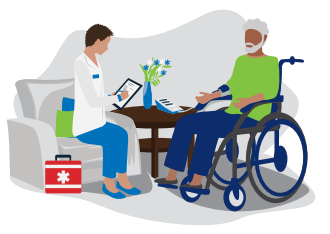Patient-Centered Care, More Than a Buzz Word?
Published in
Member Communities
on September 27, 2024
 By Sean Denning, BS, RRT, Director of Clinical Services, Corner Home Medical
By Sean Denning, BS, RRT, Director of Clinical Services, Corner Home Medical
The U.S. healthcare system has been changing and evolving since hospitals have been responsible for patient readmissions. The idea of accountable care organizations (ACO) and value-based care (VBC) has grown and expanded dramatically over the years with more hospital and health systems being involved in these healthcare delivery models. As this change is sweeping across healthcare systems, the reimbursement and payment model has also been evolving during this time. The reimbursement system is changing to a proactive approach and value-based care which is focused upon the patient’s particular healthcare needs and outcomes. Patient-centered care is the base or a main pillar in ACOs and value-based care. Patient-centered care is about empowering the patient to be actively involved in their own healthcare. Patient-centered care should not be considered a “buzz word” or even a trend in healthcare. Patient-centered care is growing and will not be going away. Corner Home Medical has been proactive and has developed numerous patient-centered programs over the past several years. We knew that if we did not evolve along with the rest of healthcare, we would, as some people would say, be on the “outside looking in.”

Patient-centered care should be looked at and developed for each individual patient we care for. As we know, each patient we care for in the home has many different social, economic, and learning abilities that can have drastic effects on a person’s individual healthcare. Patient centered care helps drive down healthcare costs while increasing the quality of care for an individual. If you’re not delivering patient-centered care, you should be asking yourself “Why not?”
Education is a key component to patient-centered care. When patients become well informed about their disease, medications, support and triggers, they will become more involved in their own healthcare. Today clinics and hospitals rarely have the staff or quality time to deliver quality education to patients. I will always remember what a physician said during a presentation a few years back about education with patients in a hospital. The physician gave the example of imagining you’re a patient in the hospital naked with a little gown while lying in bed. As you lay there you have multiple people coming in and out pulling back the curtain and talking with you.
You would be more worried about who is coming in and when can you go home. Patients absorb very little while in a hospital. With one of our patient-centered programs, we have seen a huge change when we are sitting and delivering education and developing personal goals with a patient in their home. In the home of a patient, they are more focused, more relaxed, and will be more involved in how they learn. Patients become more open and trusting with our respiratory therapists.

Proactive delivery of healthcare, which involves the patients directly, will increase access and quality of healthcare. We should ask ourselves, “What can be done in the home instead of the patient having to drive or find transportation to a clinic?” At Corner Home Medical, with our patient-centered programs, we have developed the ability to deliver a number of different clinical tests or procedures in the homes. With these results we can communicate for the patient with their physician. This decreases the delay in healthcare decisions and changes to the patient’s care directly. Patients experience a more positive healthcare experience when they are directly involved in their healthcare. Patients start actively planning their days and goals.

Corner Home Medical embraced this healthcare delivery model years ago when we first started to develop our patient-centered care programs. Our first patient-centered care program was very successful, yet we still discovered we had to improve if we wanted to continue. Knowing there was room improvement, we were still able to demonstrate a drastic decrease in readmissions, increased patient satisfaction, increased access to quicker healthcare, and the patients were more active in their communities. We have taken our first patient-centered care program and, with a few small changes, have moved it into other pieces of our respiratory business. Corner Home Medical raised the bar while changing our focus from not just delivering equipment, but to delivering a patient-centered care delivery model.

While delivering patient-centered care, you should also consider starting to collect data on your patients. Data from this type of healthcare delivery is very powerful and useful. This information that you gather on your patients can be utilized with payors, healthcare systems, and physician clinics. This data separates a DME provider from the others. In the beginning, I mentioned the concept of the ACO. Many payors, healthcare systems, physician clinics, and even nursing homes are connected to or are an established ACO. These facilities are responsible for collecting and delivering the same data that can be collected with a patient-centered care program to the Centers for Medicare and Medicaid Services (CMS).

The delivery of patient-centered care should be one of the main focuses of the DME provider. This delivery of care is one of the main components of ACOs. As I mentioned earlier, the delivery of healthcare is changing quickly, and with that change there are also changes occurring in the reimbursement. So, when a DME provider delivers patient-centered care and collects data, it will give them an advantage over others. You will not be outside looking in; you will be at the table of the payor, hospital, or physician clinic.
READ THE FULL ARTICLE HERE
 This article was originally featured in the VGM Playbook: Boosting Results in Patient-Centered Homecare. To read the full article and more like this, download your copy of the playbook today!
This article was originally featured in the VGM Playbook: Boosting Results in Patient-Centered Homecare. To read the full article and more like this, download your copy of the playbook today!
TAGS
- playbook
- vgm